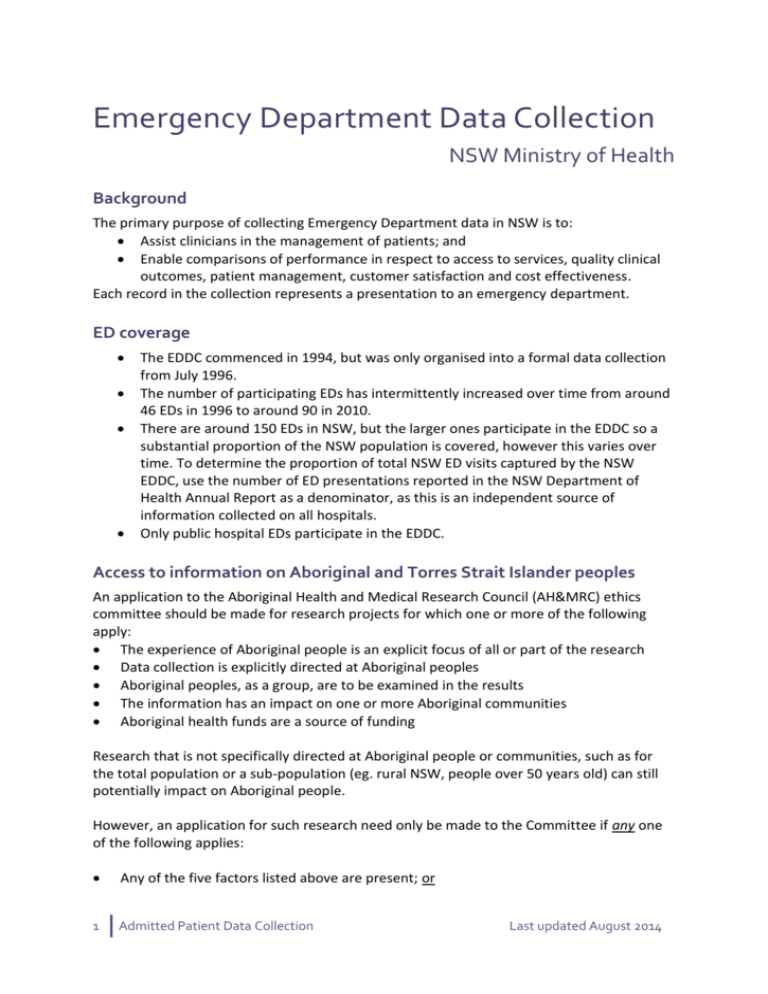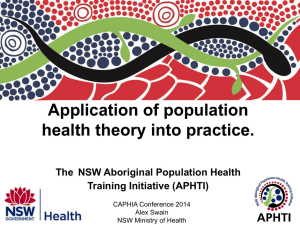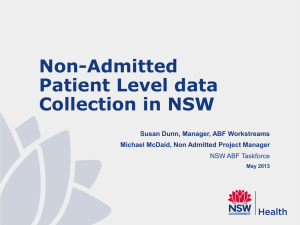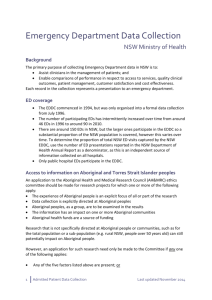Emergency Department Data Collection
advertisement

Emergency Department Data Collection NSW Ministry of Health Background The primary purpose of collecting Emergency Department data in NSW is to: Assist clinicians in the management of patients; and Enable comparisons of performance in respect to access to services, quality clinical outcomes, patient management, customer satisfaction and cost effectiveness. Each record in the collection represents a presentation to an emergency department. ED coverage The EDDC commenced in 1994, but was only organised into a formal data collection from July 1996. The number of participating EDs has intermittently increased over time from around 46 EDs in 1996 to around 90 in 2010. There are around 150 EDs in NSW, but the larger ones participate in the EDDC so a substantial proportion of the NSW population is covered, however this varies over time. To determine the proportion of total NSW ED visits captured by the NSW EDDC, use the number of ED presentations reported in the NSW Department of Health Annual Report as a denominator, as this is an independent source of information collected on all hospitals. Only public hospital EDs participate in the EDDC. Access to information on Aboriginal and Torres Strait Islander peoples An application to the Aboriginal Health and Medical Research Council (AH&MRC) ethics committee should be made for research projects for which one or more of the following apply: The experience of Aboriginal people is an explicit focus of all or part of the research Data collection is explicitly directed at Aboriginal peoples Aboriginal peoples, as a group, are to be examined in the results The information has an impact on one or more Aboriginal communities Aboriginal health funds are a source of funding Research that is not specifically directed at Aboriginal people or communities, such as for the total population or a sub-population (eg. rural NSW, people over 50 years old) can still potentially impact on Aboriginal people. However, an application for such research need only be made to the Committee if any one of the following applies: Any of the five factors listed above are present; or 1 Admitted Patient Data Collection Last updated August 2014 Aboriginal people are known, or are likely, to be significantly over-represented in the group being studied (eg. compared to the 2.1% of the total NSW population as shown in the 2006 Census); or The Aboriginal experience of the medical condition being studied is known, or is likely, to be different from the overall population; or There are Aboriginal people who use the services being studied in distinctive ways, or who have distinctive barriers that limit their access to the services; or It is proposed to separately identify data relating to Aboriginal people in the results. The AH&MRC ethics committee have some specific requirements, including evidence of community engagement in the research. Relevant documents can be found on the AH&MRC website at: http://www.ahmrc.org.au. If you are unsure whether an application to the AH&MRC Ethics Committee is required, please seek the advice of the Ethics Committee secretariat (T: 02 9212 4777). Diagnosis coding The NSW Admitted Patient Data Collection has diagnoses coded by trained clinical information managers who choose diagnoses from the Australian clinical version of the International Classification of Diseases (ICD). The EDDC, on the other hand, has diagnoses recorded by medical, nursing or clerical personnel at the point of care. These personnel are not trained in clinical coding. The diagnoses are selected by keyword searching or tables of a limited set of diagnoses. The codes are assigned to the chosen diagnosis using tables built into the computer database program. Other points to note are: There are several different computer programs used in NSW EDs. Different programs use different classifications to record the diagnosis, including ICD-9, ICD-10, or SNOMED CT (see https://nehta.org.au/aht/). If you intend analysing ED diagnoses, you need to determine the codes from each of these classifications that relate to the disease or symptom grouping to be studied. Variation in computer programs and management practices at EDs may lead to variation in diagnosis coding practices. Some disease categories are not available in some programs but may be in others. A small number of hospitals have had limited completeness of diagnosis entry over some periods of time. You should carefully select which EDs to include in the analysis based on how long the ED has participated in the EDDC and specific diagnosis code and completeness factors. Symptoms can be, and often are, selected as diagnoses. Diagnoses can be very specific or very broad. For example, someone with the same symptoms might be assigned a diagnosis of "influenza" or "viral infection". Other limitations 2 The other main source of primary care in Australia is general practice services. Because of variability in GP service availability, limited consultation hours and variation in bulk billing practices, ED activity may be very sensitive to availability of GP services. Emergency Departments have different visit types, the most common being an "Emergency Visit". The data field “Type of visit” records this, however the accuracy of Admitted Patient Data Collection Last updated August 2014 this field is uncertain. Since 2007, the gradual rollout of new ED patient management software in most NSW hospitals may have led to a change in the accuracy of this field over time. Introduction of the new ED patient management software may have led to an unpredictable change in the accuracy of the "mode of separation" field over time at some hospitals. This field records the departure status of the patient, such as "Departed following treatment", or "Admitted to a critical care ward". Some problems with this field were not identified until well after introduction of the software, and may have taken some time to correct. Aboriginality was not recorded for all ED presentations in western Sydney. Tips for using Emergency Department data in linkage studies There are no patient names in the Emergency Department Data Collection (EDDC) prior to 2000. After 2000, the proportion of records with patient names increased yearly, to 87.6% in 2005. As names are one of the principal variables used to link records between and within datasets, linkage studies should use ED data from 2005 onwards. The EDDC has substantial limitations. These limitations must be considered when planning a study using ED data, and in particular, when interpreting and presenting the data Data custodian Dr Zoran Bolevich Director Health System Information and Performance Reporting NSW Ministry of Health All questions relating to this dataset should be directed to: Lee Taylor Associate Director, Epidemiology and Biostatistics Centre for Epidemiology and Evidence NSW Ministry of Health Locked Mail Bag 961 NORTH SYDNEY NSW 2059 Phone: 02 9391 9223 Fax: 02 9391 9232 E-mail: ltayl@doh.health.nsw.gov.au 3 Admitted Patient Data Collection Last updated August 2014 Variable information Variable Date of birth Age Sex Description/Notes Full date of birth will only be supplied if sufficient justification is supplied that age is insufficient. Date of birth may otherwise be supplied as MMYYYY. The age of the patient in years Gender of the patient Indigenous status Whether the person is Aboriginal or Torres Strait Islander, based on the person’s own self-report. See notes above regarding access to this variable. Interpreter Status State of residence Postcode of residence Need for interpreter service as perceived by the patient – interpreter service may or may not have been provided The Australian state in which the patient usually resides The postcode of the patient’s usual place of residence Statistical Local Area of residence The geographical boundary assigned to the patient’s area of residence Health Area of Facility Local Health District of Facility 2005 boundaries 2011 boundaries 4 Emergency Department Data Collection Last updated August 2014 Codes 01 = Male 02 = Female 03 = Indeterminate/Intersex 09 = Not stated/Unknown 01 = Aboriginal but not Torres Strait Islander origin 02 = Torres Strait Islander but not Aboriginal origin 03 = Aboriginal and Torres Strait Islander origin 04 = Neither Aboriginal nor Torres Strait Islander 08 = Declined to respond 09 = Unknown N = Interpreter not needed Y = Interpreter needed The following codes are also valid: 9990 = Overseas 9998 = No Fixed Address (NFA) 9999 = No Further Information Available (NFIA) Codes are according to the Australian Standard Geographical Classification (ASGC) issued by the Australian Bureau of Statistics http://www.abs.gov.au/ausstats/abs@.nsf/mf/1216.0 See Attachment 1 – Area Health Services See Attachment 2 – Local Health Districts Variable Health Area of residence Local Health District of residence Facility Description/Notes The Area Health Service code for the area in which the patient resides 2011 boundaries Codes See Attachment 1 – Area Health Services The specific hospital reporting the ED episode of care. If information on specific facilities is required, these should be specified by name. 0 = No hospital cover 1 = Single room and elected doctor hospital cover 2 = Basic hospital cover 8 = Ancillary cover only 9 = Not stated DDMMYYY and HH:MM (24 hour format) DDMMYYY and HH:MM (24 hour format) 1 = Resuscitation 2 = Emergency 3 = Urgent 4 = Semi urgent 5 = Non urgent DDMMYYY and HH:MM (24 hour format) Insurance status Hospital insurance type Arrival date and time Triage date and time Triage category Date and time at which the person presents for the service Date and time at which the person is assessed by a Triage nurse Triage is the process used to classify patients according to the urgency of their needs for medical and nursing care Nurse Practitioner seen date and time Doctor seen date and time Date and time at which the person is first seen by a Nurse Practitioner Date and time at which the person is first seen by a Medical Officer 5 Emergency Department Data Collection Last updated August 2014 See Attachment 2 – Local Health Districts DDMMYYY and HH:MM (24 hour format) Variable Mode of arrival Description/Notes Mode of transport by which the person arrives Type of visit The reason the person presents to the Emergency Department 6 Emergency Department Data Collection Last updated August 2014 Codes 01 = State Ambulance vehicle 02 = Community/public transport 03 = Private vehicle 04 = Helicopter Rescue Service 05 = Air Ambulance Service 06 = Internal ambulance/transport 07 = Police/Correctional Services vehicle 08 = Other, e.g. undertakers/contractors 09 = No transport (walked in) 10 = Retrieval 11 = Internal bed/wheelchair 01 = Emergency presentation 02 = Return visit – planned 03 = Unplanned return visit for continuing condition 04 = Outpatient clinic 05 = Privately referred, non-admitted person 06 = Pre-arranged admission: without ED workup 08 = Pre-arranged admission: with ED workup 09 = Person in transit 10 = Dead on arrival 11 = Disaster Variable Referral source Description/Notes Source from which the person was referred to this service Diagnosis The diagnosis or condition established after assessment to be responsible for the person presenting to the Emergency Department. If the person is admitted as an inpatient it is the equivalent of the admission diagnosis. For Cerner FirstNet sites, this variable is captured as “Discharge Diagnosis”. For EDIS and iPM sites it is known as “Principal Diagnosis” 7 Emergency Department Data Collection Last updated August 2014 Codes 01 = Self, family, friends 02 = Specialist 03 = Outpatient clinic 04 = General Medical Practitioner or Dentist (not hospital based 05 = Residential Aged Care facility 06 = Other hospital in Area Health Service 07 = Other hospital outside Area Health Service 08 = Other hospital outside NSW 09 = Mental health 10 = Department of Community Services 11 = Other Community Service, other than Health 12 = Prison or Justice Health 14 = Occupational Health 15 = Other health service 16 = Community Health Service 17 = After hours or co-located service 18 = Hostel/group home 19 = Employer 99 = Other Cerner FirstNet sites – SNOMED CT EDIS, iPM and Health-e-care – ICD9 and ICD10 Variable Mode of separation Description/Notes The status of the person at separation from the Emergency Department Actual departure date and time For the admitted patient this refers to the time the person is either 1) transferred to a ward or other unit or 2) leaves the ED for transfer to another unit. For non-admitted patients this refers to the time at which the assessment and initial treatment is completed and/or they physically leave the department 8 Emergency Department Data Collection Last updated August 2014 Codes 01 = Admitted: To ward/inpatient unit, not a critical care ward 02 = Admitted and discharged as inpatient within ED 03 = Admitted: Died in ED 04 = Departed: Treatment completed 05 = Departed: Transferred to another hospital without first being admitted to the hospital from which transferred 06 = Departed: Did not wait 07 = Departed: Left at own risk 08 = Dead on arrival 09 = Departed: For other clinical service location 10 = Admitted: To critical care ward (including HDU/CCU/NICU) 11 = Admitted: Via operating suite 12 = Admitted: Transferred to another hospital 13 = Admitted: Left at own risk DDMMYYY and HH:MM (24 hour format) Attachment 1 – Area Health Services (AHS) Code Description X160 X170 X500 X510 X520 X530 X540 X550 X560 X570 X900 X910 X920 X930 X940 X950 X960 X970 X980 X990 X997 X998 X999 Children’s Hospital at Westmead Justice Health Sydney South West AHS South Eastern Sydney & Illawarra AHS Sydney West AHS Northern Sydney & Central Coast AHS Hunter & New England AHS North Coast AHS Greater Southern AHS Greater Western AHS Ambulance Service of NSW NSW Not Further Defined Victoria Queensland South Australia Western Australia Tasmania Northern Territory Australia Capital Territory Other Australian Territories Overseas Locality No Fixed Locality Not Stated/Other 9 Emergency Department Data Collection Last updated August 2014 Attachment 2 – Local Health Districts (LHD) Code X700 X710 X720 X730 X740 X750 X760 X770 X800 X810 X820 X830 X840 X850 X860 X630 X690 X180 X170 X910 X920 X921 X930 X940 X950 X960 X970 X980 X990 X997 X998 9999 10 Description Sydney LHD South Western Sydney LHD South Eastern Sydney LHD Illawarra Shoalhaven LHD Western Sydney LHD Nepean Blue Mountains LHD Northern Sydney LHD Central Coast LHD Hunter New England LHD Northern NSW LHD Mid North Coast LHD Southern NSW LHD Murrumbidgee LHD Western NSW LHD Far West LHD Sydney Children’s Hospitals Network St Vincent’s Health Network Forensic Mental Health Network Justice Health NSW not further specified Victoria Albury (Victoria in-reach) Queensland South Australia Western Australia Tasmania Northern Territory Australian Capital Territory Other Australian Territories Overseas Locality No Fixed Address Missing Emergency Department Data Collection Last updated August 2014







